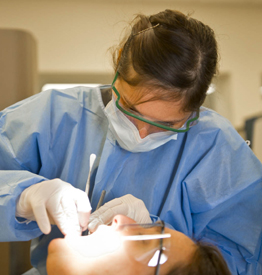Program Information
Do you enjoy variety? Our residency program offers several distinct rotations, each with diverse patient populations and each supported by an exceptional team of faculty and staff members. We believe our program offers a unique opportunity for experience and education.
Our AEGD program is a one-year program with an optional second year. Both options provide the opportunity for residents to increase their knowledge through direct patient care, lectures, seminars and workshops. In the second year, residents have greater flexibility to custom design a program permitting emphasis in his/her area of interest, including research.
Approximately 85% of your time will be devoted to advanced clinical care. The remaining 15% is didactic coursework.
Program Goals and Objectives

- To demonstrate evidence of value-added knowledge in all phases of general dentistry.
- To enhance the resident’s ability to act as the coordinator of the patient's total oral health care.
- To educate the resident in providing a comprehensive range of dental services to diverse patient groups, including medically-compromised, disabled, pediatric and geriatric populations.
- To develop lifelong learners in dentistry who can review the dental literature and use it to provide up-to-date clinical care.
- To provide opportunities for service in community dentistry projects and to provide dental treatment to underserved populations in the region.
- To educate the resident in providing dental treatment in a hospital setting.
Dental Implant Rotation Goals and Objectives
Upon completion of this rotation, the AEGD resident must be able to:
- Develop an understanding of diagnosis, treatment planning, treatment-associated complications, and maintenance procedures in implant dentistry
- Provide information about dental implants as the standard of care
- Provide a comprehensive range of dental services involving dental implants
- Manage implant complications
Oral Surgery Rotation Goals and Objectives
Upon completion of this rotation, the AEGD resident must be able to:
- Treat non-complex, intraoral infections
- Perform non-surgical extractions of teeth
- Perform surgical extractions of teeth
- Perform non-complex pre-prosthetic surgery
- Perform intraoral biopsies
- Treat intraoral hard and soft tissue trauma
- Recognize and manage oral pathologic lesions
- Treat post-operative complications
Pediatric Dentistry Rotation Goals and Objectives
Upon completion of this rotation, the AEGD resident must be able to:
- Serve as the primary care provider
- Complete a thorough history, review of systems and appropriate physical evaluation
- Complete a thorough head and neck examination
- Treat pediatric patients with simple needs as well as those with complex needs or management problems
- Use appropriate behavior management skills with the pediatric patients
Special Needs Clinic Rotation Goals and Objectives
Upon completion of this rotation, the AEGD resident must be able to:
- Provide appropriate dental services for patients with special needs
- Use a multidisciplinary, team approach in obtaining appropriate consents (e.g. power of attorney for health care) to provide dental treatment
- Manage behavioral and pharmacological issues presented by some patients with special needs
- Use adjunctive equipment to better serve patients with special needs
Hospital Rotation Goals and Objectives
Upon completion of this rotation, the AEGD resident must be able to:
- Provide appropriate operating room dental services for patients requiring this service
- Be able to understand and comply with hospital protocol
- Appropriately manage the patient and patient records in a hospital setting
Anesthesia Rotation Goals and Objectives
Upon completion of this rotation, the AEGD resident must be able to:
- Serve as the primary care provider
- Obtain informed consent(s)
- Take, record, and interpret a complete medical history
- Understand the indications for and interpretations of laboratory studies
- Coordinate with patient's physician(s), caretaker and family to determine appropriate medications/techniques that would be effective for the patient
- Interpret the physical evaluation performed by a physician with an understanding of how it impacts on proposed treatment
- Understand patient monitoring
- Evaluation and management of airway
- Demonstrate an understanding of medications used to achieve general anesthesia, sedation, and/or an anxiolytic state
- Correctly use pharmacological agents in the treatment of dental patients
- Demonstrate an understanding of prevention, recognition, and management of complications related to the use and interactions of medications used for general anesthesia, sedation and anxiety control











